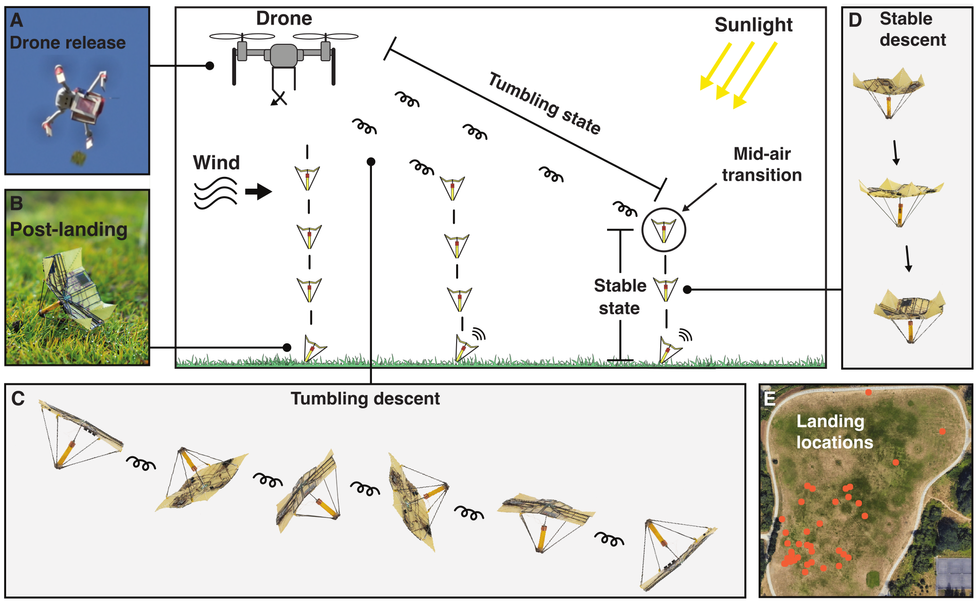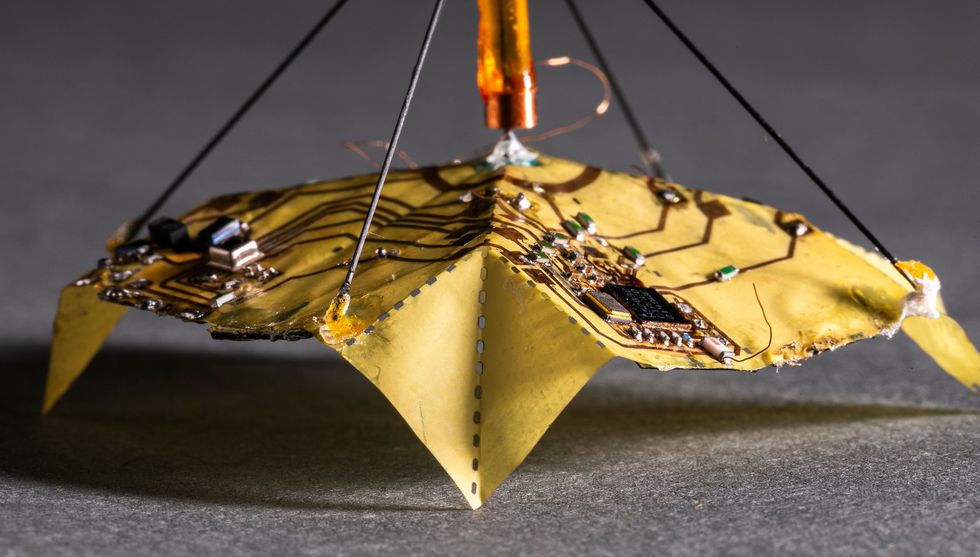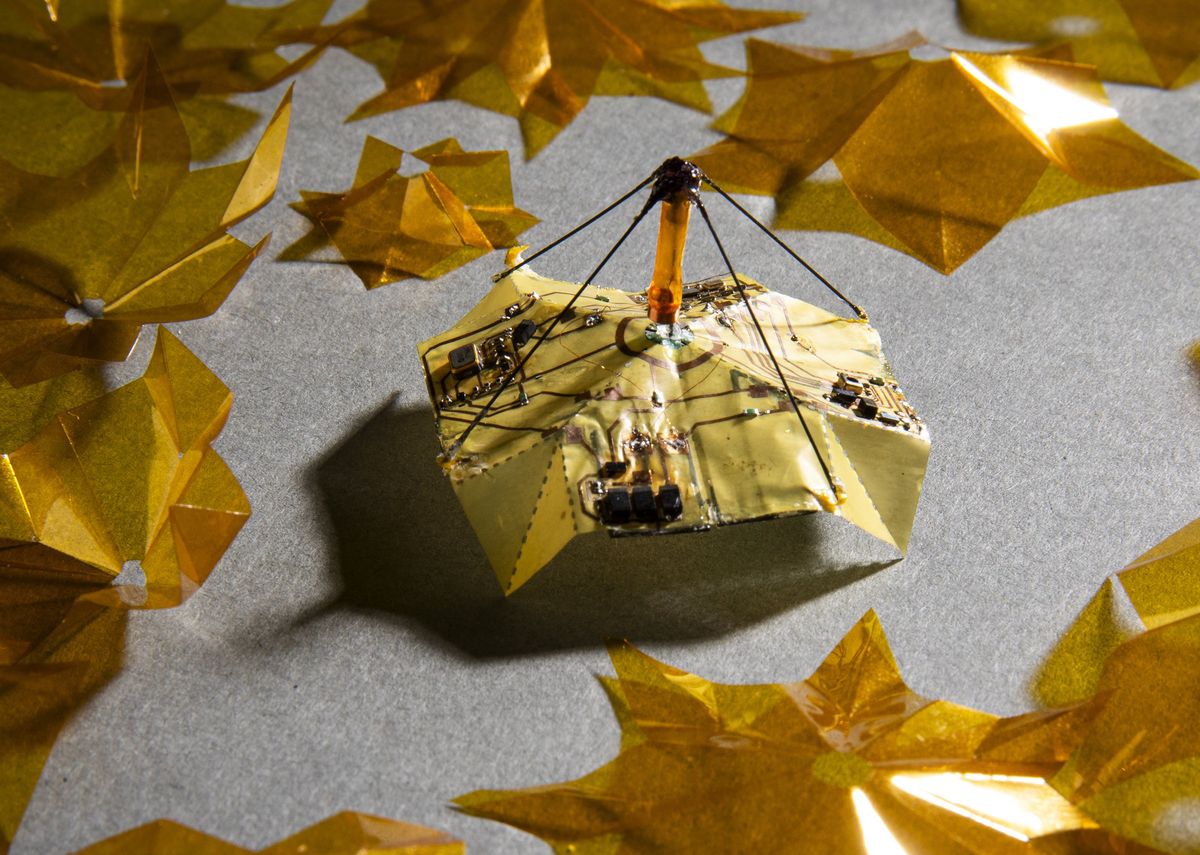Microfliers, or miniature wireless robots deployed in numbers, are sometimes used today for large-scale surveillance and monitoring purposes, such as in environmental or biological studies. Because of the fliers’ ability to disperse in air, they can spread out to cover large areas after being dropped from a single location, including in places where access is otherwise difficult. Plus, they are smaller, lighter, and cheaper to deploy than multiple drones.
One of the challenges in creating more efficient microfliers has been in reducing power consumption. One way to do so, as researchers from the University of Washington (UW) and Université Grenoble Alpes have demonstrated, is to get rid of the battery. With inspiration from the Japanese art of paper folding, origami, they designed programmable microfliers that can disperse in the wind and change shape using electronic actuation. This is achieved by a solar-powered actuator that can produce up to 200 millinewtons of force in 25 milliseconds.
“Think of these little fliers as a sensor platform to measure environmental conditions, like, temperature, light, and other things.”
—Vikram Iyer, University of Washington
“The cool thing about these origami designs is, we’ve created a way for them to change shape in midair, completely battery free,” says Vikram Iyer, computer scientist and engineer at UW, one of the authors. “It’s a pretty small change in shape, but it creates a very dramatic change in falling behavior…that allows us to get some control over how these things are flying.”

This research builds on the researchers’ earlier work published in 2022, demonstrating sensors that can disperse in air like dandelion seeds. For the current study, “the goal was to deploy hundreds of these sensors and control where they land, to achieve precise deployments,” says coauthor Shyamnath Gollakota, who leads the Mobile Intelligence Lab at WU. The microfliers, each weighing less than 500 milligrams, can travel almost 100 meters in a light breeze, and wirelessly transmit data about air pressure and temperature via Bluetooth up to a distance of 60 meters. The group’s findings were published in Science Roboticsearlier this month.
Discovering the difference in the falling behavior of the two origami states was serendipity, Gollakota says: “When it is flat, it’s almost like a leaf, tumbling [in the] the wind,” he says. “A very slight change from flat to a little bit of a curvature [makes] it fall like a parachute in a very controlled motion.” In their tumbling state, in lateral wind gusts, the microfliers achieve up to three times the dispersal distance as in their stable state, he adds.

There have been other origami-based systems in which motors, electrostatic actuators, shape-memory alloys, and electrothermal polymers, for example, have been used, but these did not address the challenges facing the researchers, Gollakota says. One was to find the sweet spot between an actuation mechanism strong enough to not change shape without being triggered, yet lightweight enough to keep power consumption low. Next, it had to produce a rapid transition response while falling to the ground. Finally, it needed to have a lightweight energy storage solution onboard to trigger the transition.
The mechanism, which Gollakota describes as “pretty commonsensical” still took them a year to come up with. There’s a stem in the middle of the origami, comprising a solenoid coil (a coil that acts as a magnet when a current passes through it), and two small magnets. Four hinged carbon-fiber rods attach the stem to the edges of the structure. When a pulse of current is applied to the solenoid coil, it pushes the magnets toward each other, making the structure snap into its alternative shape.
All it requires is a tiny bit of power, just enough to put the magnets within the right distance from each other for the magnetic forces to work, Gollakota says. There is an array of thin, lightweight solar cells to harvest energy, which is stored in a little capacitor. The circuit is fabricated directly on the foldable origami structure, and also includes a microcontroller, timer, Bluetooth receiver, and pressure and temperature sensors.
“We can program these things to trigger the shape change based on any of these things—after a fixed time, when we send it a radio signal, or, at an altitude [or temperature] that this device detects,” Iyer adds. The origami structure is bistable, meaning it does not need any energy to maintain shape once it has transitioned.
The researchers say their design can be extended to incorporate sensors for a variety of environmental monitoring applications. “Think of these little fliers as a sensor platform to measure environmental conditions, like temperature, light, and other things, [and] how they vary throughout the atmosphere,” Iyer says. Or they can deploy sensors on the ground for things like digital agriculture, climate change–related studies, and tracking forest fires.
In their current prototype, the microfliers only shape-change in one direction, but the researchers want to make them transition in both directions, to be able to toggle the two states, and control the trajectory even better. They also imagine a swarm of microfliers communicating with one another, controlling their behavior, and self-organizing how they are falling and dispersing.
- AI, Drones Survey Great Barrier Reef in Last Ditch Effort to Avoid Catastrophe ›
- Tanzania Builds a Drone Industry From Local Know-How and Bamboo ›
Payal Dhar (she/they) is a freelance journalist on science, technology, and society. They write about AI, cybersecurity, surveillance, space, online communities, games, and any shiny new technology that catches their eye. You can find and DM Payal on Twitter (@payaldhar).



